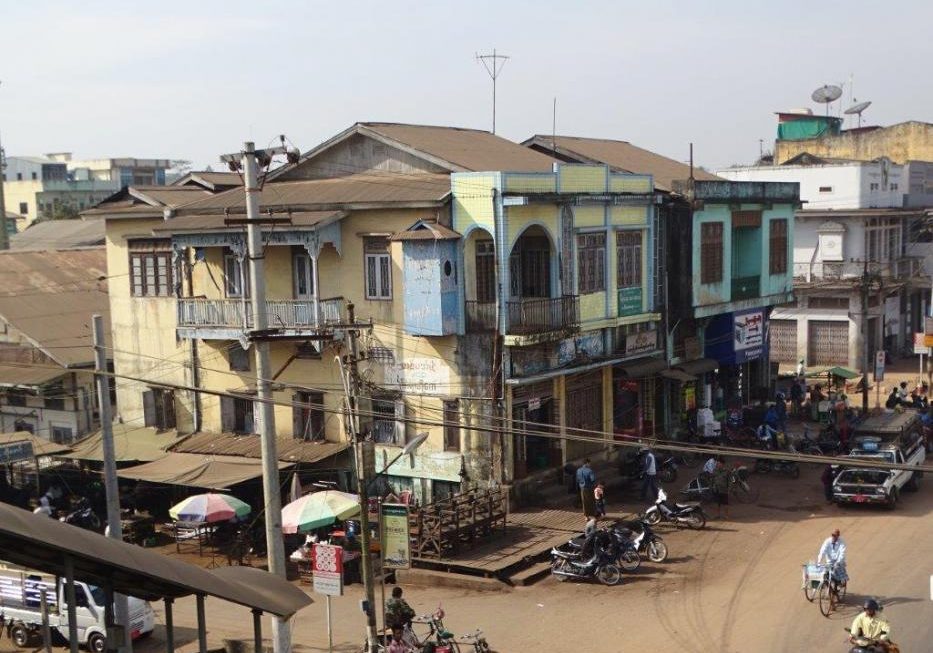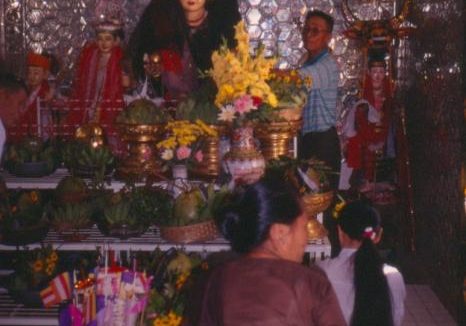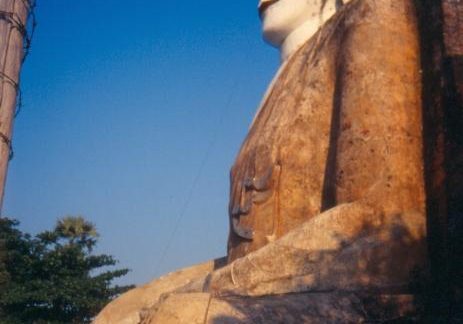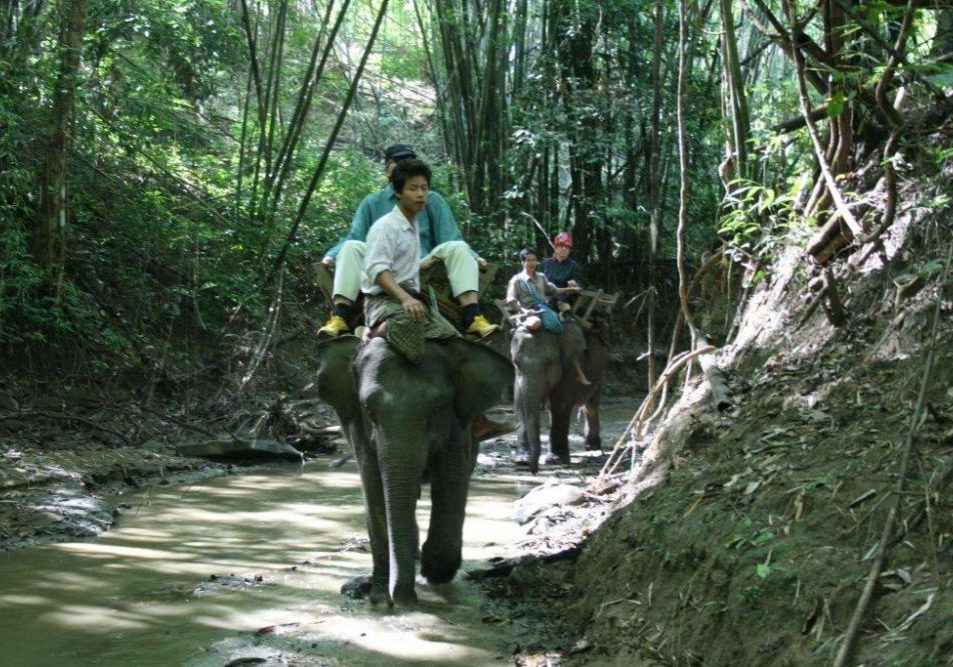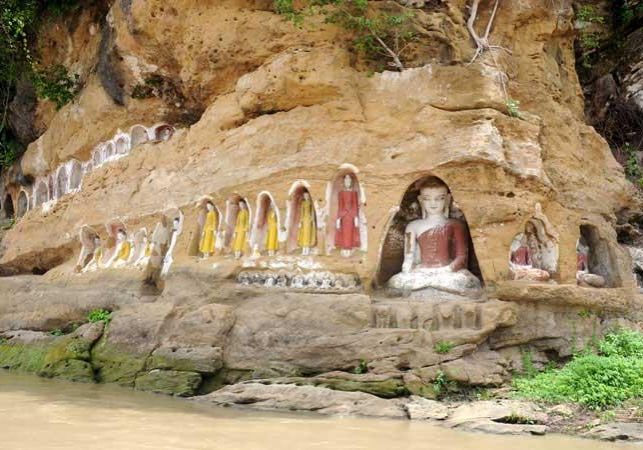Bago Division is the second biggest producer of paddy after Ayeyarwaddy division. It is bordered by Magway Division and Mandalay Division to the north; Kayin State, Mon State and the Gulf of Martaban to the east; Yangon Division to the south and Ayeyawardy Division and Rakhine State to the west. Highlights are Bago, Taungoo and the ruins of the ancient Pyu kingdom near Pyay
How to get there
Bago and Pyay are easily accessible by rail or by car. It is only a 2 hours drive from Yangon to Bago and a 5 hours drive on a very good road to Pyay.
Places of interest
BAGO
Used to be the ancient capital of the Mon Kings from the 14th through the 16th century and that of the Second Myanmar Empire founded by King Bayinnaung. Bago is situated only 80 km north-east of Yangon.
DIE SHWE-MAW-DAW PAGODA
Was originally built by the Mon to a height to 23 meters in the 8th century and was rebuilt higher several times until it finally reached its present 114 meter stature in 1954. Visitors can see in the Pagoda Museum a number of ancient Buddha images of stone and bronze found in the damaged top part of the pagoda after the earthquakes.
SHWE-THA-LYAUNG
Is the large reclining image of the Buddha, 180 feet in length and 52.5 feet in height. This is one of the largest reclining Buddha images in the world. Traditionally believed to have been built by King Migadipa in AD 944. It was restored by Ramadhipatiraja (1472-1492) but later 'lost'. Rediscovered 1880 and restored again several times to bring it to this condition.
HINTHAKONE PAGODA
Tradition has it that Hinthakone is the hill where the two sacred mythical ducks called nintha (Hamsa) alighted, when only the very top of the hill was above the ocean. The name Hantha-wadi or Hamsavati by which Bago and her kingdom were known, originated from this name. It has good views over Bago from the hilltop.
THE HANTHAWADI PALACE
Kanbawza Thadi, the famous palace of King Bayinnaung (1551-1581 A.D.) is being extensively excavated and some buildings are being rebuilt. King Bayinnaung was the founder of the Second Myanmar Empire, which stretched from the borders of India to parts of Thailand and Laos. In 1566 A.D. he built a new capital city called Hanthawadi on what is now Bago. To the south of the Shwe-Maw-Daw Pagoda he built a grand palace, which he named Kanbawza Thadi.
There is also an interesting archaeological museum on the excavation site.
KYAIK PUN PAGODA
Was built by King Dhamma Zedi in 1476 A.D. The pagoda ss in the form of four gigantic Buddha images all in sitting posture facing the four cardinal points of the compass. They are seated back to back against a massive brick pillar. This unusual and impressive pagoda is only a few hundred feet of the Yangon – Bago road.
Other places of interest near Bago
MOYINGYI WETLANDS & RESORT
Only 2 ½ hours from Yangon is a paradise for bird watchers. The best season to visit is from November to March. The 100 square kilometers wetlands is host to 75 species of elusive migratory and resident water birds including: Little Cormorant, Grey and Purple Herons, Indian Pond-Heron, Asian Openbill, Black-headed Ibis, Garganey, Lesser Whistling duck, Pied Harrier, Western and Eastern Marsh-Harriers, Purple Swamp hen, Pheasant-tailed and Bronze-winged Jacanas, Oriental Pratincole, Whiskered Tern, Striated Grass bird, Oriental Reed-Warbler, Zitting Cist cola, etc. We might see an Oriental Darter, Spot-billed Pelican, Cinnamon Bittern, Painted Stork, Wooly-necked Stork, Lesser Adjutant, Pallas's Fish-Eagle, Greater Spotted Eagle, Sarus Crane, Watercock, Black-winged Stilt or Asian Golden Weaver. The Resort offers simple, but clean rooms with air-con and attached bathroom.
TAUNGOO
Located 175 miles from Yangon and is the only place for the tourists where you can get good accommodation on Yangon-Mandalay road. Taungoo (Kaytumadi City) was founded by King Mingyinyo in 1510 A.D and later innovated by King Minye Kyawhtin. All the four sides of the city wall are still very conspicuously seen, with the exception of the part of the southern wall. The wall is built of bricks. The moat surrounding the city is dried up, except in some of its sections on the eastern side, where it is purposely kept and properly maintained. About 6.4 m from the wall city is the first moat filled with soft mud, which is about 9.6 m wide. It is one of the main gateways to Bago Yoma and its teak forests and is worth exploring. It derives much of its importance these days from the timber trade and the teak forests on which its economy depends visibly seen on the mountain ranges lying to the east and west of the town beckon visitor. Even its ancient empire has long since crumbled; Taungoo remains an important pilgrimage site for Buddhist devotees who flock regularly to Shwesandaw pagoda.
Taungoo is also a good starting point to visit one of the Elephant Camps towards the Bago Yoma, which means Bago mountain ranges. It is the home of the best teak, and the topography of Bago Yoma is a place of genuine beauty.
PYAY
Once was called Prome after the British occupied Myanmar is located 285 km north-west of Yangon. Pyay is easily accessible by road or rail and a gateway city to Rakhine State, across the Ayeyawaddy River. It is a major trading zone where all the products from Rakhine State and middle part of the country trade in and exchange with those come from the lower part of the country. Today Pyay is a sleepy town with a small river harbour which serves as a transshipment point for cargo moving between Upper and Lower Myanmar along the Ayeyarwaddy River.
THAYEKHITTAYA (SRIKESTRA)
An ancient capital of Pyu Kingdom which flourished between 5th to 9th century known as Thayekhittaya (Sriksetra). The ruins are hidden behind thickness of thorny bushes, small trees, toddy palms, cactus and beautiful white flowers. The ruins are such as Patagyi Pagoda, Payama Pagoda, Bawbawgyi Pagoda & Bebe Pagoda, which are supposed to be built between 4th to 9th century. The small museum has a collection of artifacts collected from the excavations, including royal funerary urns, stone relieves, a couple of Bodhisattavas, a Dvrapala (great guardian), statues of the Hindu deities Tara Devi, Vishnu & Lakshmi, several 6th century Buddha images, tile fragments, terracotta votive tablets and silver coins minted in the kingdom.
AKAUK HILL
On the other side of Pyay across the Ayeyarwaddy river, there lies Akauk Taung hill ranges. In the 19th century, because of the British annexation over Lower Myanmar, the country was split into Upper (ruled by Myanmar King) and Lower (ruled by British). The river was the major transportation for trading between two parts and it was the place where all the boats stopped and were checked for trading taxes. Thus the place was named after taxes, in Myanmar called “taxes”. The hills are full of Buddha Images, which are believed to be done by the traders when they stopped for a while. We can find various fossils of cold-blooded animals, such as snails, fishes especially inhabited in the ocean.
SHWETAUNG
Is a small town located about 270 km north-west of Yangon and only 15 km away from Pyay. It was once a part of Thayekhittaya (Sriksetra) Kingdom. It lies between Yangon-Pyay Highway and the mighty Ayeyarwady (Irrawaddy) River. Shwetaung has two famous pagodas. The Shwemyettman Pagoda, “Pagoda of Golden Spectacles” and the second is Shwenattaung Pagoda, “Pagoda of Golden Spirit Mountain.”

